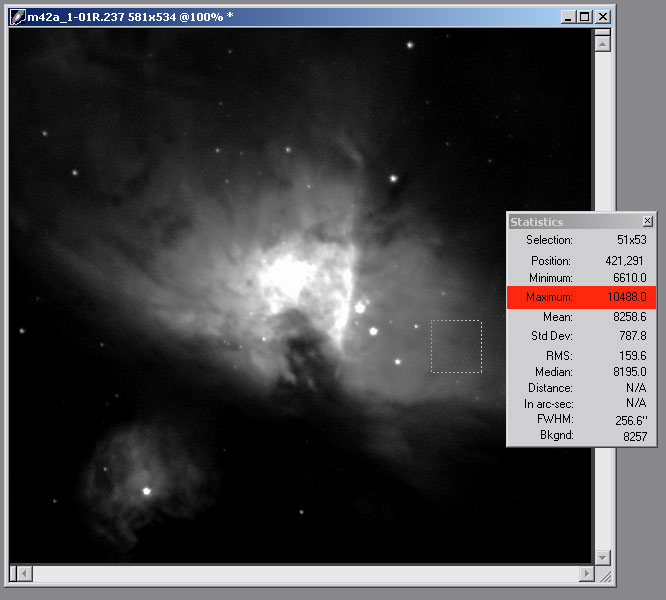
There are many ways to decide on how long a sub-exposure should be. Here I present a technique I use with all my exposures.
Sub-exposures are a necessity for a really deep, high S/N imaging. With my HX916, I couldn't take a single 60 minute exposure even if I wanted to: the sky glow at F/6.5 would be sufficient to saturate the whole image. On the other hand, if I don't take a long enough sub-exposure, I'll lose some faint
details, and will likely increase the noise in the image.
Take as long a sub-exposure as possible without
saturating any of the important parts of the image
To accomplish this I usually take a test exposure of the field through the filter I'll
want to use.
First, I take a 1 minute exposure. If I don't see the object I'm after in the image (nebula, galaxy, star, etc) I take a longer
exposure until I do:

In this test image, I measure the maximum ADU count of the brightest visible part of the
target object, say it's 10,000. I then know that if I take an image that's 10 times as long as the test, the count in this region will be approximately
(10000-3000) * 10 + 3000 = 73,000 ADU
73k is well beyond saturation, so a 10 minute exposure would be
inappropriate. I may want to try something closer to 7 minutes that will result in an ADU count of
52,000:
(10000-3000) * 7 + 3000 = 52,000
This is based on the following formula:
ADUx = (ADUn - P) * (x / n) + P
where ADUx is the ADU
value after an exposure of length x,
ADUn
is the ADU value after the test exposure of length n,
and P
is the constant pedestal ADU value for the camera (for my HX916 it's about 3000)
Another thing to remember is that binning 2x2 increases ADU count in each resulting pixel by about 4x compared to an image binned 1x1 (four neighboring pixels are added up to produce one binned pixel). If it takes 2 minutes to get
an adequate signal binned 2x2, it will take approximately 8 minutes to get the same level of signal binned 1x1.
I often take a binned test exposure, and then calculate the time for exposure
binned 1x1 by multiplying by 4.
Hope you find this useful. If you have any corrections, additions, or other tips or tricks, I'd like to hear about them.
Copyright © 2002 Paul Kanevsky